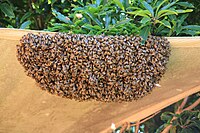
Changes in hypopharyngeal glands of nurse bees (Apis mellifera) induced by pollen-containing sublethal doses of the herbicide Roundup®.
Sign Up to like & getrecommendations! Published in 2018 at "Chemosphere"
DOI: 10.1016/j.chemosphere.2018.07.189
Abstract: Decreasing pollinator populations worldwide has generated great concern and stimulated countless studies to understand the origin of colony losses. One main cause is the indiscriminate use of different pesticides, producing subtle negative effects on bee… read more here.
Keywords: glands nurse; changes hypopharyngeal; nurse bees; royal jelly ... See more keywords

Fungicide Exposure in Honey Bee Hives Varies By Time, Worker Role, and Proximity to Orchards in Spring
Sign Up to like & getrecommendations! Published in 2023 at "Journal of Economic Entomology"
DOI: 10.1093/jee/toad008
Abstract: Abstract Fungicides are commonly applied to prevent diseases in eastern North American cherry orchards at the same time that honey bees (Apis mellifera L. (Hymenoptera: Apidae)) are rented for pollination services. Fungicide exposure in honey… read more here.
Keywords: time; honey; honey bees; fungicide exposure ... See more keywords

Learning, gustatory responsiveness and tyramine differences across nurse and forager honeybees
Sign Up to like & getrecommendations! Published in 2017 at "Journal of Experimental Biology"
DOI: 10.1242/jeb.152496
Abstract: ABSTRACT Honeybees are well known for their complex division of labor. Each bee sequentially performs a series of social tasks during its life. The changes in social task performance are linked to gross differences in… read more here.
Keywords: bees foragers; tyramine receptors; tyramine; nurse bees ... See more keywords